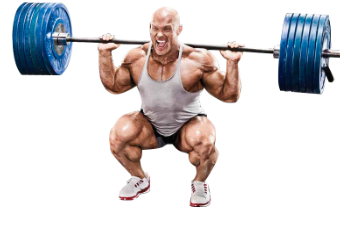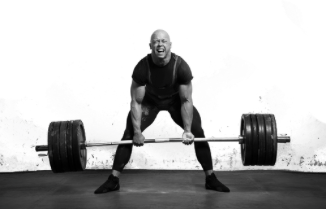Fast Twitch vs. Slow Twitch: Fated For Gains?
Building the Perfect Beast - How Our Fast and Slow Twitch Muscle Fibers Determine Athletic Success...

Building the Perfect Beast - How Our Fast and Slow Twitch Muscle Fibers Determine Athletic Success...
Whey protein has been used in one form or another for at least 300 years, yet it has taken until ...
With an overwhelming amount of research demonstrating its benefits, ‘resistant starch’ blows away many of the sexier sounding supplements that ...
Most hard working bodybuilders, from rank beginner to seasoned pro, will experience some degree of training-related muscle soreness. Whether experienced ...
Worried about overtraining? MI40 Top Gun Bryce Bahm is here with some simple steps you can take to byass the ...
Is it true that resistance training stunts growth in adolescents? And can lifting really reverse the ageing process in older ...
In the last two installments of this series, we laid out and explained concerns and guidelines for buying fruits, vegetables, ...
An ability to build thick layers of lean muscle indefinitely is one trait no bodybuilder will ever possess, despite any ...
What you need to know in review: Carbs have a direct effect on the release of insulin Insulin is considered ...
Why Should You be eating Resistant Starch? RS is a starch that when digested in the large intestine, leads to ...
Let’s face it – seeking out the right information can be confusing whether you are a bodybuilder or just an ...
 Picture yourself cranking out a heavy set of squats, your training partner counting down as rep number 20 of an ultra-brutal series approaches. The final rep has arrived and you can hardly bring it to completion. Lungs burning, breathless, and with fully-pumped quad muscles screaming for mercy, you are ready to rack the weight. However, your partner has other ideas and, with no warning given, demands 10 more reps. Unable to think clearly, stomach churning with nausea, you must make an important decision: continue or quit, fight or flight. Knowing that winners never quit, you mentally commit to achieving the seemingly impossible. A remarkable series of complex biochemical processes are on standby, ready to assist you in such an event. Before you can properly rationalize all the implications of your decision to continue, the amygdala of the brain engages a neural response causing the pituitary gland to release the hormone ACTH (Adrenocorticotropic hormone), which immediately tells the adrenal glands to produce the hormone cortisol.[2] Your blood sugar, heart rate, and blood pressure all skyrocket.[4] Immune system activity ceases (the body has more immediate concerns and must mobilize only that which is necessary to complete its mission). Fatty
Picture yourself cranking out a heavy set of squats, your training partner counting down as rep number 20 of an ultra-brutal series approaches. The final rep has arrived and you can hardly bring it to completion. Lungs burning, breathless, and with fully-pumped quad muscles screaming for mercy, you are ready to rack the weight. However, your partner has other ideas and, with no warning given, demands 10 more reps. Unable to think clearly, stomach churning with nausea, you must make an important decision: continue or quit, fight or flight. Knowing that winners never quit, you mentally commit to achieving the seemingly impossible. A remarkable series of complex biochemical processes are on standby, ready to assist you in such an event. Before you can properly rationalize all the implications of your decision to continue, the amygdala of the brain engages a neural response causing the pituitary gland to release the hormone ACTH (Adrenocorticotropic hormone), which immediately tells the adrenal glands to produce the hormone cortisol.[2] Your blood sugar, heart rate, and blood pressure all skyrocket.[4] Immune system activity ceases (the body has more immediate concerns and must mobilize only that which is necessary to complete its mission). Fatty  acids align with glucose to boost energy levels. And finally, the catecholamines, including norepinephrine, are called upon to facilitate immediate physical reactions to complete a task that would be out of the question under less harrowing circumstances. What happens next is largely directed by how well prepared you are for violent muscular contraction. With 300lbs pressing down on your spine and nothing left in the tank you have no choice but to lift, or lose.
acids align with glucose to boost energy levels. And finally, the catecholamines, including norepinephrine, are called upon to facilitate immediate physical reactions to complete a task that would be out of the question under less harrowing circumstances. What happens next is largely directed by how well prepared you are for violent muscular contraction. With 300lbs pressing down on your spine and nothing left in the tank you have no choice but to lift, or lose.
The nature and intensity of your behavioral response and the planning of how best to approach such a mammoth effort, both prompted by norepinephrine release, will, it is hoped, guide you to the completion of all ten additional reps. Fully prepared, your breathing and lung function increases to deliver more oxygen to the body and brain; metabolic processes such as digestion and growth are halted so the blood that is normally used for these actions can be directed to the muscles and brain; blood vessels leading to muscles are dilated so more fuel and oxygen can be delivered; and muscle tension is increased to provide the body with extra strength and speed. With the aid of norepinephrine, you successfully mobilize the energy and aggression needed to max out at 30 reps – the ‘emergency’ has passed. Because of the enormously taxing nature of this event, the body cannot sustain such an intense onslaught for very long. Your breathing is calmed, your nerves are no longer on edge, your senses are no longer heightened, hunger, thirst, elimination and other bodily functions are returned to normal. Until the next set, it is all systems go.
The Science
 The chemical primarily responsible for helping us to focus and (along with epinephrine) initiate the fight-or-flight response is norepinephrine – a.k.a. noradrenaline. Adopting many roles, as a neurotransmitter, norepinephrine affects multiple areas of the brain, in particular the amygdala, an almond-shaped group of nuclei situated deep within the temporal lobes. Here, norepinephrine directs attention and helps to control our responses to external environmental stimuli. [7][2][9]
The chemical primarily responsible for helping us to focus and (along with epinephrine) initiate the fight-or-flight response is norepinephrine – a.k.a. noradrenaline. Adopting many roles, as a neurotransmitter, norepinephrine affects multiple areas of the brain, in particular the amygdala, an almond-shaped group of nuclei situated deep within the temporal lobes. Here, norepinephrine directs attention and helps to control our responses to external environmental stimuli. [7][2][9]
As a neurotransmitter released from the postganglionic sympathetic neurons of the peripheral nervous system, norepinephrine stimulates cardiovascular function and increases blood flow to working muscles. It also initiates the release of glucose from energy stores, and provides more oxygen to the brain. Critical for the functioning of the heart, elevated norepinephrine causes an increase in heart rate to prepare the body for increased physical activity. [4][1][6]
As outlined earlier, norepinephrine enables us to do the seemingly impossible; to intently focus on completing tasks which demand our combined energy resources and immediate action. By enhancing respiration, increasing muscle activity, boosting heart rate, and intensifying muscle contraction, norepinephrine transforms the way we respond to a acute stressor. Because norepinephrine mobilizes fat molecules to generate additional energy, it allows the body to burn fat more efficiently as well [8, 10].
Maintaining Balance
Norepinephrine is a neurotransmitter and hormone that must remain in proper balance with other chemicals of the catecholamine family to ensure our biological systems function as they should, when they should. Too much norepinephrine and we may become anxious, irritable, and aggressive, and our muscles may remain constantly tensed and prepared for action; all of which may combine to deplete our energy reserves. On the other hand, low levels of norepinephrine may cause poor cognition, depression, and a loss of alertness. In most circumstances our bodies are experts at orchestrating the exact amount of norepinephrine we need, but if your levels are problematically low the following steps can be taken.
In Conclusion
Whenever we are forced to confront an unexpected obstacle, to swing into action at a moment’s notice, we react by increasing our brain activity. When it comes to processing information and charting a course of action, we have norepinephrine to thank for giving us the ability to mentally conceive and physically respond in an expedient manner. Furthermore, norepinephrine transcends the boundaries of the central nervous system to initiate the cascade of physiological effects that allow us to push past seemingly insurmountable obstacles. Norepinephrine is a formidable weapon in our fight for growth, and it is not to be trifled with.
References